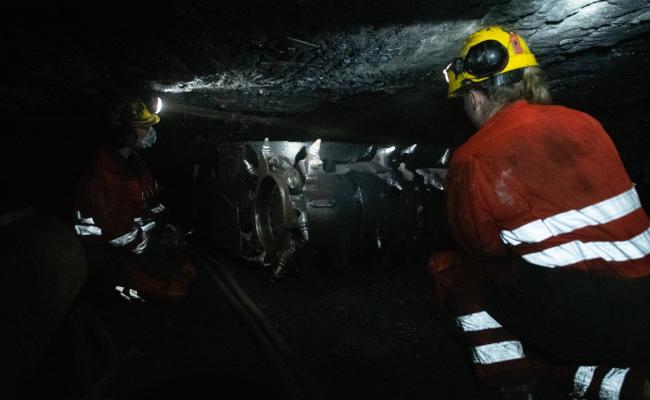The Arctic Circle Assembly 2023: A Nuclear Power Renaissance?
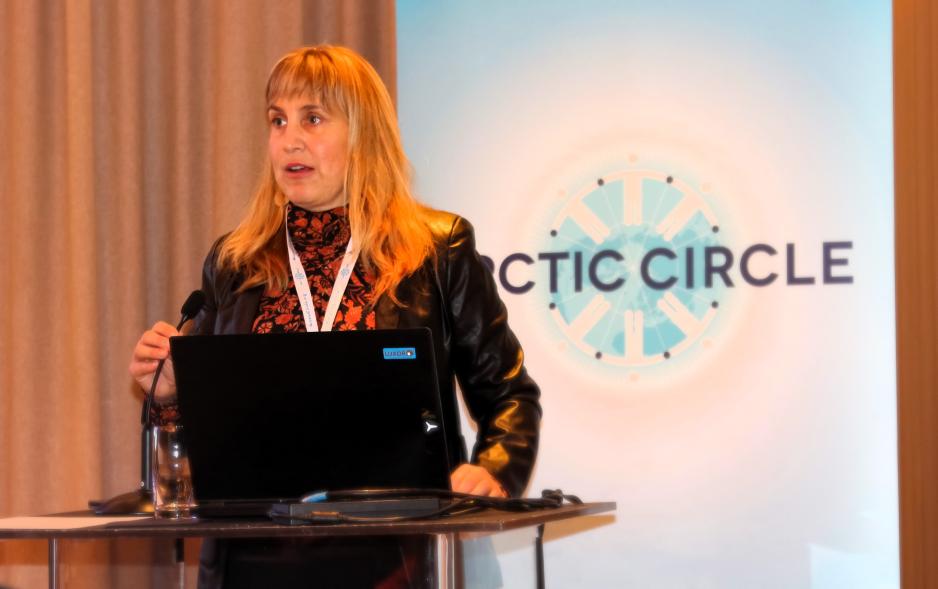
Seniorforsker Gwen Holdman ved universitetet i Fairbanks, Alaska, delte informasjon fra studien om kjernekraft i Arktis under Arctic Circle Assembly 2023 i Reykjavik, Island. (Foto: Trine Jonassen)
Reykjavik (High North News): Nuclear power as an energy source is heading for the Arctic. "There is a nuclear power renaissance in the US. The challenge is that nuclear energy is associated with weapons," says Senior Researcher Gwen Holdman at the Alaska Center for Energy and Power.
The world is on the hunt for climate-friendly and carbon-free energy, and several countries are looking at nuclear power as an opportunity to replace diesel in remote Arctic communities.
However, when people hear nuclear power, they often respond emotionally based on outdated knowledge.
Does nuclear power just need a good PR agent to turn its bad reputation around?
Strong reactions
Senior Researcher Gwen Holdman at the Alaska Center for Energy and Power at the University of Alaska Fairbanks has no doubts;
"There is a nuclear power renaissance in the US."
We need to change the dialogue about nuclear power
Holdman is behind a study about the use of nuclear power as an energy source in Alaska. But when she asked the people about nuclear power, strong reactions emerged, which she believes to not necessarily be based in updated knowledge.
"We need to change the dialogue about nuclear power. There are a lot of feelings around the subject due to nuclear weapons. People have just seen the Oppenheimer movie and how badly it turned out and they immediately think about an 80-year-old technology," says Holdman.
"We see an emotional reaction that does not consider how far technology has come."
Several catastrophes
Nuclear power has been used for energy for almost 70 years and is currently used in over 30 countries. In the US, nuclear power generates 20 percent of all electricity, roughly the same as all renewable energy combined.
Nuclear power has also been used in Alaska before, in the 1960s at Fort Greely, the US Army's launch site for anti-ballistic missile defense. The reactor is now to be dismantled after being out of service for over 50 years.
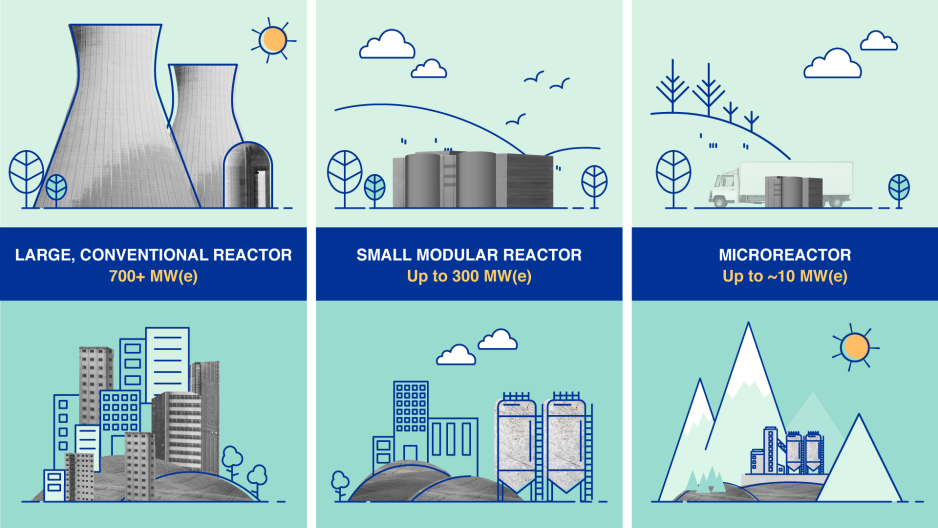
Small modular reactors (SMR) have a power capacity of up to 300 MW(e) per unit. Many SMRs, which can be factory assembled and transported to a place for installation, are meant for markets such as industrial applications or remote areas with limited grid capacity. (Illustration: A. Vargas/IAEA)
Catastrophic accidents such as the Three Mile Island accident in 1979, the Chernobyl accident in 1986, and the Fukushima accident in 2011 are still fresh in people's minds, in addition to three accidents on nuclear-powered submarines between 1961 and -85.
But this is the past, says Gwen Holdman, and states that the world must look forward and northward.
More reactors are being planned
Nuclear power as an energy source in the Arctic was one of the major topics at the Arctic Circle Assembly conference in Reykjavik last week.
The big conversation was primarily about the placement of small modular reactors (SMR - reactors under 300 MW) and microreactors (up to 10 MW), which can be placed in remote communities and which almost operate themselves, should we believe the researchers.
Several US companies are now planning to develop modular reactors to replace diesel-operated generators in the rural Arctic.
Also read
Lack of deposit option
But the road to nuclear power as an energy source in the Arctic is paved with unclear consequences and costs, explains Professor August Valfells, who works at Reykjavik Technical College.
The use of nuclear power in small modular must comply with the International Atomic Energy Agency's (IAEA) security measures, which include security functions, management constraints, personnel security, and security for physical structures, areas, and units.
The disposal of radioactive waste is an obstacle, and as of today, only Finland is building the world's first permanent repository for high-level nuclear waste on the island of Olkiluoto. It takes around 10,000 before the uranium that is buried is at the same radiation level as when it is extracted from nature.
But the radioactive waste must be buried for even longer - for 100,000 years.
Today's climate measures may become a headache for future generations.
They sprinkled radioactive waste on the tundra.
In the wrong hands
"The only real option that exists today is an intermediate solution, in which the radioactive fuel rods are lowered into a pool to lock in the radioation for five to ten years. This also cools down the radioactive substance," explains Valfells.
The fuel rods then have to be stored over a longer period of time, and that is a solution that does not exist yet. Dry cask storage is therefore being used indefinitely.
Another problem with commercializing nuclear reactors is, of course, that uranium could fall into the wrong hands and be used for weapons.
The transport of nuclear fuel to remote areas is also unclear, and possible long-term damage to the surrounding environment has not yet been mapped.
Guinea pigs
In Alaska, extra attention ought to be given to the "Chariot" experiment, the state's past trampling of the indigenous population.
"The indigenous communities must be part of the process and the decisions that are made," says Diane Hirshberg, Director of the Institute of Social and Economic Research and Professor of Education Policy at the University of Alaska Anchorage.
In light of the state coming close to testing nuclear explosives near Alaska and using the indigenous people as guinea pigs for medical projects, it is not difficult to imagine that the population is skeptical of having nuclear reactors placed in their neighborhoods.
The Chariot Project
In 1958, it was decided to build an artificial harbor at Cape Thompson in Alaska by burying and detonating nuclear devices. A research project to find peaceful uses for nuclear explosives.
The indigenous community of the Inupiaq village protested, and the project was put on hold. The Soviet Union also protested. The project was never formally stopped.
Environmental studies showed that radioactive contamination from the explosion would have had a negative impact on the local population, whose livelihood was based on hunting.
The investigations showed that radiation from worldwide fallout moved rapidly up the food chain in the Arctic, from lichens to reindeer to humans.
The explosions would have thawed the permafrost, making the soil around the harbor unstable.
The soil was nevertheless contaminated by radioactivity from an experiment to measure the effect radioactive waste has on water sources, followed by fallout on the arctic tundra.
The radioactive waste "Chariot" site was halted in 1962 but never formally canceled. Thirty years later, waste from another test site was discovered in archival documents by a researcher from the University of Alaska.
Residents of the Inupiat village of Point Hope, which had experienced an "unusually high" incidence of cancer deaths, demanded that the contaminated soil be removed. This happened in 1993.
In addition, the US government exploded nuclear weapons on the Aleutian island of Amchitka until the 1970s.
Source: Princeton University
No trust
"They sprinkled radioactive waste on the tundra," says Diane Hirshberg during an Arctic Circle panel discussion.
Now she wants to make sure that history does not repeat itself.
"The US has a long history of targeting vulnerable people who do not speak English. The legacy of America is mistrust. The state did not clean up the waste until the 1990s, and even then, they did not take it all and had to come back."
Wants nuclear power
"We must listen to the concerns of the people of Alaska. Just consider the nuclear reactor pilot project at Eielson Air Force Base in Fairbanks. It did not start with a conversation with the citizens. Without dialogue, the people also do not understand what is different about this technology," Hirshberg points out.
"People hear nuclear power and only know that everyone in the family has had cancer. There are a number of misunderstandings out there. But we are interested in nuclear power, we just do not want it to happen under the auspices of the state. And the local community must lead the development. It is the only path to trust. Nothing can be placed on Alaskan land without approval from the local community," says Diane Hirshberg.
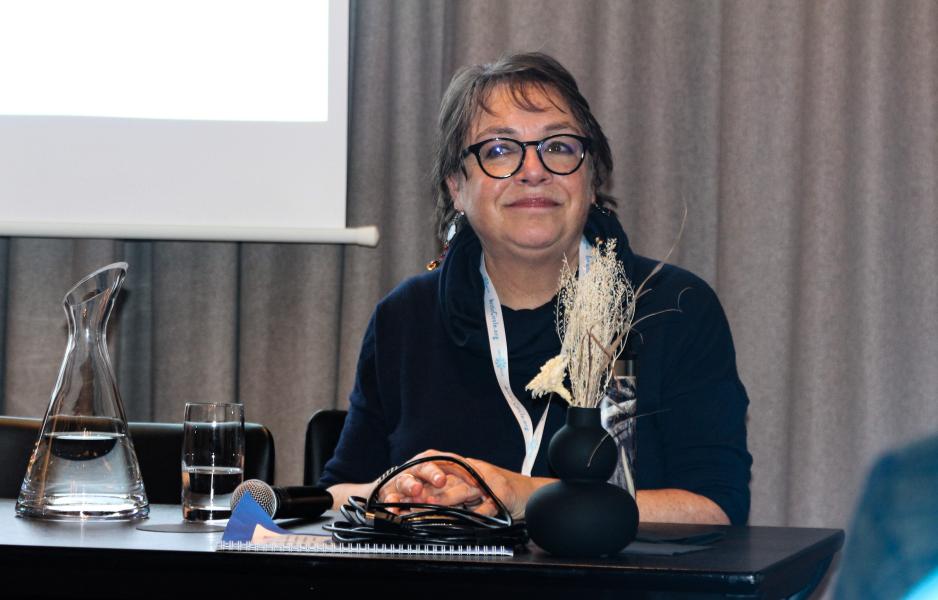
Diane Hirshberg, Director of the Institute of Social and Economic Research and Professor of Education Policy at the University of Alaska Anchorage. During the Arctic Circle Assembly 2023 in Reykjavik, she pleaded the indigenous peoples' cause in the debate about nuclear power in Alaska. (Photo: Trine Jonassen)
Gwen Holdmann assures that the technology now being developed specifically for remote areas cannot be compared to the old reactors.
"And small modular reactors and microreactors are also safer because they are smaller. They use passive safety, which means it will shut down automatically when heated up instead of running wild. It is when the cooling fails that accidents happen."
Conversations with Nome
She points to the town of Nome, Alaska, with a population of 3,000. There, they are investigating the possibility of replacing diesel with nuclear power. Holdman herself was in Nome last year to give a presentation to residents.
"In Nome, a 5MW reactor is enough to supply people with electricity," Holdman points out and refers to examples of small nuclear reactors that are being planned.
She also emphasizes that this technology is under development and that many of these projects will not take place for up to ten years:
- Project Pele: Developed for the US Department of Defense. A deployable nuclear power reactor for use in remote operating bases for the United States Armed Forces. Complete in late 2024 or early 2025.
- Ultra Safe Nuclear Corporation (USNC). A nuclear underground battery that can be replaced.
- Westinghouse Electrical Company is building a small 5MW modular reactor
- Eielson Air Force Base in Alaska has a pilot program for a microreactor.
The Iodine Experiment in Alaska
From 1956 to 1957, the US Air Force conducted a study to determine whether the thyroid gland played a role in cold acclimation using iodine 131.
The study involves 200 administrations of I-131 to 120 test subjects, including 101 members of the indigenous population, many of whom did not speak English.
The study gave radionuclides to the indigenous population - including children - likely without consent.
Subjects in the Alaska I-131 experiment had no medical benefit from the iodine.
Source: Georgetown University.
Replaces diesel
So what are the disadvantages of using nuclear energy in the Arctic? The timeline, first and foremost. Climate change is happening fast, and the technology is not ready. As already stated, it may take ten years.
All nuclear facilities, including the small ones, may experience serious accidents which can cause extensive and long-term contamination.
However, there must be a thorough discussion of what nuclear power replaces, which are diesel generators with risks of emissions and long and sometimes frequent transport, believes Gwen Holdman.
Responsible
"A nuclear reactor has few paths for contamination. The small ones are built to take care of themselves to a large extent and need few employees."
She says that the extraction of uranium must also be taken into account. Where does the uranium come from, and what are the local consequences of mining?
Also read
However, given the nuclear reactor's long lifespan and the fact that it is carbon-free energy, Holdman believes it to be a responsible solution.
Have to talk about it
But it will be expensive. There are no exact figures for the exact costs for a local community yet.
"If it is much more expensive than diesel, people will not switch to nuclear power."
But she believes in the power of conversation and says they must do a better job informing people.
Wider support
"Support grew significantly in Alaska after information was provided via general meetings and courses. Nuclear power should be part of our future choice because it is carbon-free. It will not be cheap, but the costs flatten out over time," she says.
We do not have to educate a whole generation of engineers
The models that are planned today will be fully built at the factory and transported and assembled where they need to go. The reactors use passive safety measures, which is a big difference from previous, larger nuclear power plants. They require minimal staff and, like the larger reactors, can go for long intervals without refueling.
"So we do not have to educate a whole generation of engineers," says Holdman.
Transport challenges
When asked about the CO2 footprint of uranium extraction, she replies that this mining operation does not stand out from other mining operations, such as coal mines.
"But off course, no energy solution is complete without a footprint. It is my hope that 20 years from now, we will no longer be using diesel generators."
Safe transport of the reactors is also a big topic. A nuclear train to Alaska must go via Canada, and that requires special permits.
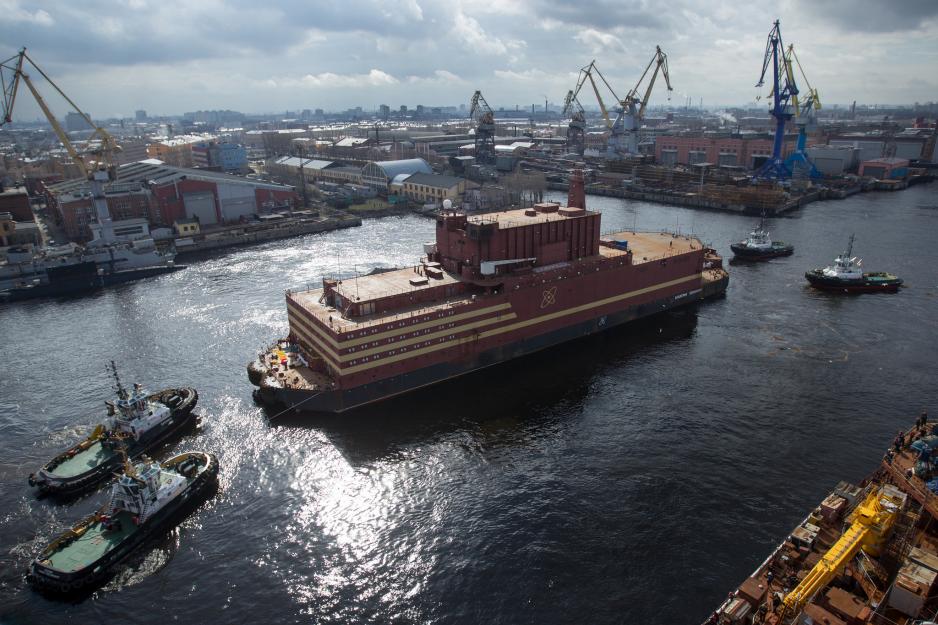
Russia was the first to come up with modular reactors. Akademik Lomonosov is the world's first floating nuclear power plant and has been in operation since May 2020. The power plant produces energy from two 35 MW(e) modules. (Photo: Rosatom)
Or the reactors must be transported by sea on large barges. Because nuclear reactors weigh a bit, and several coastal communities have never received such large barges before. But nuclear fuel is transported to and from the coast all the time, Gwen Holdman reminds the assembly.
"We are just not aware of it."
Holdman insists that she is a big supporter of renewable energy, such as water, solar and wind, but that it will never be enough to supply remote towns with heat and light around the clock for years.
"Use renewable energy where possible. But if we want to switch to a carbon-free solution in the Arctic, we have no other choice."
Not possible without nuclear power
Andrew Light, Assistant Secretary of Energy in the US Department of Energy, says in a speech at the conference that the development of small modular reactors is about to change dramatically.
We will soon see private reactors.
"I have been asked to refrain from using the term "renaissance" about nuclear power because every time we do, something happens that sets us back," Light chuckles.
"But we will soon have private reactors. The Biden administration knows all too well that it is impossible to keep everyone alive without nuclear power. But we understand that not everyone is ready for it."
Predicts a tripling
Light says a number of actions are needed to keep the 1.5-degree target alive and predicts a tripling of nuclear power use by 2030.
Light concludes that we will get there with the technology, but we have to get there politically as well.
Currently, only Russia and China have this type of nuclear reactor in operation. Russia's is located at Pevek in the East Siberian Sea, and China's - Linglong One - is located in the Chinese province of Hainan in the South China Sea and was completed this summer.
Argentina, Russia, and China have several reactors under construction, while Russia, the USA, Canada, South Korea, Denmark, Great Britain, and Sweden have modular nuclear reactors of several types under development.



